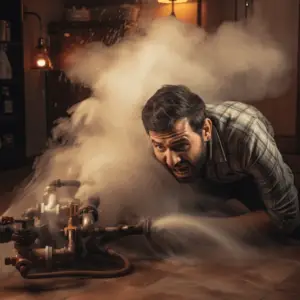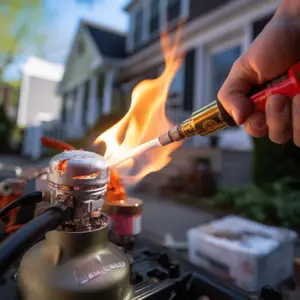Gas leaks can be dangerous and it’s crucial to identify them. Specialists suggest strategies to locate them effectively. This helps people detect gas leaks quickly and take action to avoid any danger.
Here are some steps to identify gas leaks:
- Inspect the gas meter first. Check if the reading rises or varies when no devices are in use. An unexpected growth means a possible leak. Make sure the pipes and fittings linked to the meter are tightly secured without any cracks or damage.
- Also, a nasty smell like rotten eggs could mean a gas leak. Natural gases like methane have no smell, but are blended with a stinky substance called mercaptan for easy detection. If you notice this smell indoors, investigate and take action right away.
- Be aware of hissing sounds near gas lines or appliances. Gas escaping from pipelines often makes these sounds due to pressure differences or broken connections. If you hear such noises, shut off the main gas supply and get help quickly.
- Install carbon monoxide detectors too. Carbon monoxide (CO) is an invisible and odorless gas that can be released during incomplete combustion processes with natural gas or other fossil fuels. The CO may mean a leak or incorrect ventilation system in devices like heaters or stoves.
In conclusion, recognizing gas leak signs is essential for safety in residences and businesses. By examining meters regularly, being alert to strange odors and noise, and using carbon monoxide detectors properly, people can protect themselves from potential hazards. Taking preventive steps and getting professional help fast can save lives and property from possible accidents caused by gas leaks.
Table of Contents
Signs of a gas leak
A gas leak can be dangerous and life-threatening. It’s important to identify the signs of a gas leak in order to stay safe. These signs include:
- Strange odor like rotten eggs or sulfur. Don’t ignore this smell!
- A hissing sound from the source of the leak.
- Dying or distressed plants, as gas leaking into the soil can harm roots.
- Physical symptoms in humans, such as headaches, dizziness, nausea, fatigue and difficulty breathing.
- Bubbling or discolored water near gas appliances or pipelines.
Also, some gases are colorless and odorless. It’s essential to have regular maintenance checks from qualified professionals. In case of suspected gas leaks, turn off the main supply valve and ventilate the area by opening windows and doors. Seek professional assistance right away.
Steps to spot a gas leak

Gas leaks can be dangerous! Here’s a 3-step guide to help you spot them.
- Unusual odors: Gas leaks often smell like rotten eggs or sulfur.
- Listen for noises: Hissing or blowing sounds near gas appliances might suggest a leak.
- Look for signs: Dead plants near pipelines, or bubbles in standing water.
Safety first! If you suspect a gas leak:
- Leave the area.
- Don’t use electrical switches – sparks could be hazardous.
- Contact emergency services and your utility provider.
Don’t ignore any signs of a possible gas leak. Take action to stay safe – explosions and fires are possible if left unattended.
What to do if you suspect a gas leak
Gas leaks can be hazardous and must be taken seriously. If you think there is a gas leak, take immediate action for your safety and those around you. Here’s what to do:
- Stay still and evaluate the situation. Look for signs like a sulfur smell, hissing or whistling near gas appliances or pipes, or dead plants in the area.
- Don’t use matches, lighters, or electrical switches as sparks can ignite a fire or explosion.
- Leave the area right away and don’t stop for belongings or to open windows.
- Call your gas provider or emergency services to report the suspected leak.
- Don’t return until an expert from your gas provider or emergency services says it is safe.
Detecting a gas leak early can prevent accidents and save lives, so know the signs and act fast if you think there is one.
To stay safe, inspect and maintain gas appliances regularly, install carbon monoxide detectors, learn the location of shut-off valves and how to turn them off, and never attempt gas line repairs or alterations yourself. Following these steps can help keep you and your property safe.
Preventive measures for gas leaks

Regular inspection? Schedule it pronto! A pro can check for gas leaks and make sure gas appliances, pipelines, and fittings are in top condition. Ventilation’s a must too – it helps prevent natural gas build-up and reduces the risk of leakage. Carbon monoxide detectors? Install them in your home. They can detect this deadly byproduct early and you can take action. Flammable stuff? Store it far from gas appliances. Don’t use gas ovens or stovetops as heating sources either. Unusual odors? Check out that sulfur-like smell that natural gas has so you know when to evacuate and call emergency services.
Plus, prevention isn’t the only way to go. In case of a gas leak, remember three things:
- Don’t use lights or electrical devices.
- Open windows and doors.
- Contact emergency services ASAP.
Long story short, inspect regularly, ventilate, install carbon monoxide detectors, store safely, and sniff out unusual odors. That’s how you can keep your home and loved ones safe from gas leaks.
Conclusion
It’s essential to recognize the signs of a gas leak. Look for a gas smell, hissing, or dying vegetation. Also, don’t ignore symptoms like dizziness or nausea.
If you think there’s a leak, act fast!
- Evacuate the area and avoid any sources of ignition.
- Contact your local gas company or emergency services.
Specialized equipment like combustible gas detectors aid in locating gas leaks accurately. This helps spot gas levels that human senses may miss.
Prevention is better than cure. Inspect your gas appliances for any damage and have professionals service them regularly.
Be aware of how to detect a gas leak. Take the right measures and get expert help to reduce the risks. According to National Grid Gas Distribution, mercaptan (which smells like rotten eggs) is added to natural gas so it’s easier to detect.
Frequently Asked Questions
Q: What are the common signs of a gas leak?
A: Common signs of a gas leak include a rotten egg smell, hissing or whistling sounds near gas appliances or pipes, dead plants or grass near a gas line, and a white cloud or fog over an area of ground.
Q: What should I do if I suspect a gas leak?
A: If you suspect a gas leak, you should immediately leave the area and avoid using any potential sources of ignition, such as light switches or matches. Once you are at a safe distance, call your gas company or emergency services to report the leak.
Q: Can a gas leak be dangerous?
A: Yes, a gas leak can be extremely dangerous. Natural gas is highly flammable, and a spark or flame can lead to an explosion or fire. Inhaling natural gas can also cause health issues, including dizziness, nausea, and difficulty breathing.
Q: How do I locate the source of a gas leak?
A: To locate the source of a gas leak, you can use a gas leak detector, which is a handheld device that can detect the presence of gas in the air. You can also look for any visible signs of a leak, such as discolored or bubbling pipes.
Q: Is it possible to fix a gas leak myself?
A: It is not recommended to fix a gas leak yourself. Gas leaks should only be handled by trained professionals who have the necessary tools and expertise. Attempting to fix a gas leak without proper knowledge can be dangerous and may result in further damage.
Q: How can I prevent gas leaks in my home?
A: To prevent gas leaks in your home, ensure that gas appliances are properly installed and regularly maintained. It is also important to keep the area around gas appliances clean and free of debris. Additionally, installing carbon monoxide detectors can provide an early warning system for gas leaks.
